По всем вопросам обращайтесь на: info@litportal.ru
(©) 2003-2024.
✖
The Kingdom of God is Within You; What is Art?
Настройки чтения
Размер шрифта
Высота строк
Поля
A la nue accablante tu
Basse de basalte et de laves
A même les échos esclaves
Par une trompe sans vertu.
Quel sépulcral naufrage (tu
Le soir, écume, mais y baves)
Suprême une entre les épaves
Abolit le mât dévêtu.
Ou cela que furibond faute
De quelque perdition haute
Tout l'abîme vain éployé
Dans le si blanc cheveu qui traîne
Avarement aura noyé
Le flanc enfant d'une sirène.[114 - This sonnet seems too unintelligible for translation. – Tr.]
("Pan," 1895, No. 1.)
This poem is not exceptional in its incomprehensibility. I have read several poems by Mallarmé, and they also had no meaning whatever. I give a sample of his prose in Appendix I. There is a whole volume of this prose called "Divagations." It is impossible to understand any of it. And that is evidently what the author intended.
And here is a song by Maeterlinck, another celebrated author of to-day: —
Quand il est sorti,
(J'entendis la porte)
Quand il est sorti
Elle avait souri …
Mais quand il entra
(J'entendis la lampe)
Mais quand il entra
Une autre était là …
Et j'ai vu la mort,
(J'entendis son âme)
Et j'ai vu la mort
Qui l'attend encore …
On est venu dire,
(Mon enfant j'ai peur)
On est venu dire
Qu'il allait partir …
Ma lampe allumée,
(Mon enfant j'ai peur)
Ma lampe allumée
Me suis approchée …
A la première porte,
(Mon enfant j'ai peur)
A la première porte,
La flamme a tremblé …
A la seconde porte,
(Mon enfant j'ai peur)
A la seconde porte,
La flamme a parlé …
A la troisième porte,
(Mon enfant j'ai peur)
A la troisième porte,
La lumière est morte …
Et s'il revenait un jour
Que faut-il lui dire?
Dites-lui qu'on l'attendit
Jusqu'à s'en mourir …
Et s'il demande où vous êtes
Que faut-il répondre?
Donnez-lui mon anneau d'or
Sans rien lui répondre …
Et s'il m'interroge alors
Sur la dernière heure?
Dites lui que j'ai souri
De peur qu'il ne pleure …
Et s'il m'interroge encore
Sans me reconnaître?
Parlez-lui comme une sœur,
Il souffre peut-être …
Et s'il veut savoir pourquoi
La salle est déserte?
Montrez lui la lampe éteinte
Et la porte ouverte …[115 - For translation, see Appendix IV.]
("Pan," 1895, No. 2.)
Who went out? Who came in? Who is speaking? Who died?
I beg the reader to be at the pains of reading through the samples I cite in Appendix II. of the celebrated and esteemed young poets – Griffin, Verhaeren, Moréas, and Montesquiou. It is important to do so in order to form a clear conception of the present position of art, and not to suppose, as many do, that Decadentism is an accidental and transitory phenomenon. To avoid the reproach of having selected the worst verses, I have copied out of each volume the poem which happened to stand on page 28.
All the other productions of these poets are equally unintelligible, or can only be understood with great difficulty, and then not fully. All the productions of those hundreds of poets, of whom I have named a few, are the same in kind. And among the Germans, Swedes, Norwegians, Italians, and us Russians, similar verses are printed. And such productions are printed and made up into book form, if not by the million, then by the hundred thousand (some of these works sell in tens of thousands). For type-setting, paging, printing, and binding these books, millions and millions of working days are spent – not less, I think, than went to build the great pyramid. And this is not all. The same is going on in all the other arts: millions and millions of working days are being spent on the production of equally incomprehensible works in painting, in music, and in the drama.
Painting not only does not lag behind poetry in this matter, but rather outstrips it. Here is an extract from the diary of an amateur of art, written when visiting the Paris exhibitions in 1894: —
"I was to-day at three exhibitions: the Symbolists', the Impressionists', and the Neo-Impressionists'. I looked at the pictures conscientiously and carefully, but again felt the same stupefaction and ultimate indignation. The first exhibition, that of Camille Pissarro, was comparatively the most comprehensible, though the pictures were out of drawing, had no subject, and the colorings were most improbable. The drawing was so indefinite that you were sometimes unable to make out which way an arm or a head was turned. The subject was generally 'effets' —Effet de brouillard, Effet du soir, Soleil couchant. There were some pictures with figures, but without subjects.
"In the coloring, bright blue and bright green predominated. And each picture had its special color, with which the whole picture was, as it were, splashed. For instance, in 'A Girl Guarding Geese,' the special color is vert de gris, and dots of it were splashed about everywhere; on the face, the hair, the hands, and the clothes. In the same gallery – 'Durand Ruel' – were other pictures by Puvis de Chavannes, Manet, Monet, Renoir, Sisley – who are all Impressionists. One of them, whose name I could not make out, – it was something like Redon, – had painted a blue face in profile. On the whole face there is only this blue tone, with white-of-lead. Pissarro has a water-color all done in dots. In the foreground is a cow, entirely painted with various-colored dots. The general color cannot be distinguished, however much one stands back from, or draws near to, the picture. From there I went to see the Symbolists. I looked at them long without asking any one for an explanation, trying to guess the meaning; but it is beyond human comprehension. One of the first things to catch my eye was a wooden haut-relief, wretchedly executed, representing a woman (naked) who with both hands is squeezing from her two breasts streams of blood. The blood flows down, becoming lilac in color. Her hair first descends, and then rises again, and turns into trees. The figure is all colored yellow, and the hair is brown.

















